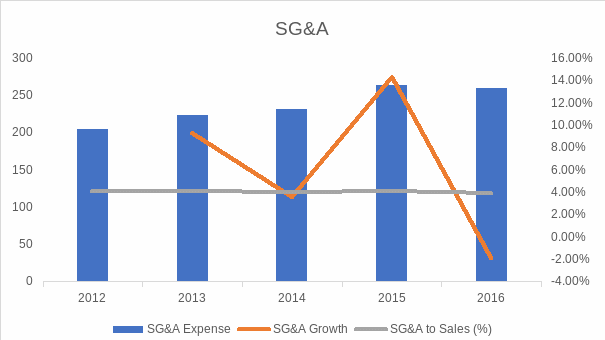Costs and Expenses
The analysis shows that the company’s selling, general, and administrative (SG&A) expenses had a mixed trend during 2012-16. It is noted from Figure 1 given below that SG&A expenses increased from 2013 to 2015. However, they declined by 1.89% in 2016.

The net profit margin of the company increased in the five years from 2.57% in 2012 to 11.44% in 2016. It shows that the growth in the company’s sales was well supported by its cost management strategy and low fuel price. However, an increase in the fuel price can affect its profit margin. Furthermore, the proportion of operating expenses to sales also declined in that period. It shows that the company was able to control its expenses, which had a positive impact on its pretax income (Dess, McNamara, Eisner, & Lee, 2019).
Table 1. Net Profit Margin and Operating Expenses to Revenue.
There are other ratios such as gross profit margin, non-operating income to EBIT, unusual expenses to EBIT, and interest cover that are also useful for evaluating the financial performance of the company.
Successful Period
The particular year in which the company reported net income growth of 138.69% was 2014 and its EPS (Basic) growth was 128.85%. In that year, the company had a significant non-operating income of $234 million which boosted its pre-tax income by 123.30%. The key area of success was that the company managed its SG&A expenses well in 2014 as they grew by only 3.59% as compared to 9.31% in 2013 (Dess et al., 2019).
Trend Analysis
The case analysis indicates that the operating margin of JetBlue was 19.65% in 2016, which was higher than its three major competitors. It shows that the company’s strategy to cut its costs and improve and modernize its fleet was effective to generate a higher profit margin. The financial analysis indicates that the company achieved sales growth every year, and it benefited mainly by low fuel prices. Moreover, it managed its operating expenses well to generate high profit margin during 2012-16. Another significant trend observed was that the interest expense reduced consistently over the five years (Dess et al., 2019).
Based on Porter’s Five Forces Model, it could be stated that JetBlue operated in a highly competitive market where the rivalry between companies was intense based on price, limited gate space, and mergers between airliners.
The company relied on low-cost A320 Airbus models to compete in the northern region of the US market. However, it means that the supplier had a high degree of power. Another strategy of the company was to offer better cabin experience with leather seats to its customers. It emphasized the importance of high-quality service to its customers at a low cost due to fearsome price wars and zero switching costs which made it very challenging for the company to compete with other airliners including American Airlines, Southwest, and United Airlines (Dess et al., 2019).
Reference
Dess, G., McNamara, G., Eisner, A., & Lee, S. (2019). Strategic Management (9th ed.). New York, NY: McGraw Hill.